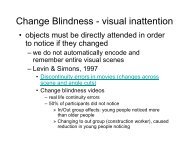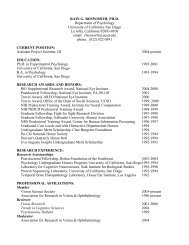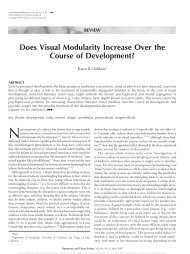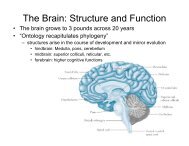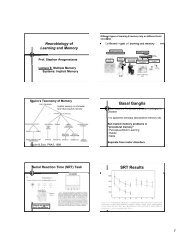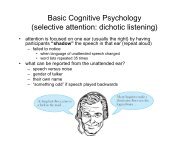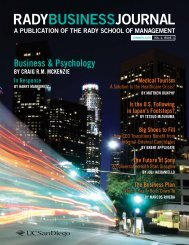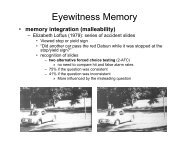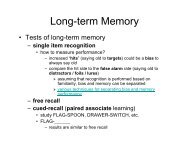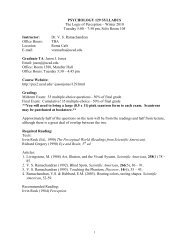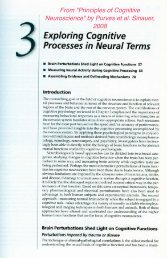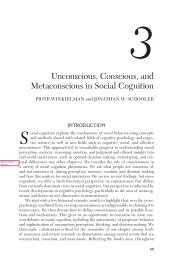Perception of Fourier and non- Fourier motion by ... - ResearchGate
Perception of Fourier and non- Fourier motion by ... - ResearchGate
Perception of Fourier and non- Fourier motion by ... - ResearchGate
Create successful ePaper yourself
Turn your PDF publications into a flip-book with our unique Google optimized e-Paper software.
© 2000 Nature America Inc. • http://neurosci.nature.com<br />
articles<br />
but a relatively higher response at low spatial frequencies, consistent<br />
with the above models. The OMI varied very little with carrier<br />
pixel size (Fig. 3d), although it dropped when the pixel size<br />
was significantly below the fishes’ expected limit <strong>of</strong> resolution, six<br />
degrees 16 . In all experiments <strong>and</strong> conditions, we ensured that the<br />
response to the control movie was zero.<br />
Finally, we tried to enhance the response to the second-order<br />
stimulus <strong>by</strong> animating the CM gratings more smoothly at the higher<br />
velocities, although the responses were always weaker than during<br />
a high contrast LM movie (Fig. 3e). Increasing the frame update rate<br />
introduced an additional variable, flicker rate, which may also<br />
increase the response <strong>of</strong> the fish <strong>by</strong> making the stimulus more salient.<br />
The noise carrier was updated every 125, 62.5 or 31.25 ms, <strong>and</strong> the<br />
CM grating, which always moved with the same mean velocity, was<br />
either updated at the same rate (Fig. 3e, white bars) or every 125 ms<br />
(gray bars). The higher rates <strong>of</strong> flicker did not significantly enhance<br />
the strength <strong>of</strong> the <strong>motion</strong> stimulus per se, unless the smoothness<br />
<strong>of</strong> the grating animation also improved. This experiment suggested<br />
that spatial contrast is the salient <strong>motion</strong> cue in this stimulus. It<br />
also provided evidence that responses to second-order stimuli are<br />
true <strong>motion</strong> responses, as smoother <strong>motion</strong> with the same target<br />
displacement gave a larger response. To further verify this, we<br />
replayed the most smoothly animated movie, but reset it every 187.5<br />
ms, so that the net displacement was zero. The fish still responded<br />
(Fig 3e; white bar, right).<br />
To determine whether contrast-modulated <strong>motion</strong> was the<br />
only type <strong>of</strong> second-order <strong>motion</strong> that the fish could see, we<br />
a<br />
b<br />
© 2000 Nature America Inc. • http://neurosci.nature.com<br />
showed two other second-order stimuli, to which the fish gave a<br />
consistent response (Fig. 4). The first stimulus, which was driftbalanced,<br />
consisted <strong>of</strong> a static array <strong>of</strong> black <strong>and</strong> white pixels<br />
(Fig. 4a). Between movie frames, the black pixels <strong>of</strong> every ninth<br />
column turned white, <strong>and</strong> white pixels turned black. In consecutive<br />
frames, these flicker-defined stripes drifted column-<strong>by</strong>-column<br />
to the left, causing humans to perceive a moving illusory<br />
column. Strikingly, the fish also followed the flickering column<br />
to the left (OMI ± s.d., 0.51 ± 0.03), in the strongest <strong>of</strong> all the<br />
second-order responses observed. A simple brightness <strong>non</strong>-linearity,<br />
or even full-wave rectification, were not enough to explain<br />
this response.<br />
We then presented a movie <strong>of</strong> drifting columns defined <strong>by</strong><br />
oblique sinusoidal gratings, oriented alternately at +45° <strong>and</strong> –45°<br />
(Fig. 4b, left). The adjacent gratings created an illusory contour,<br />
which humans could clearly see. The phase <strong>of</strong> the grating was r<strong>and</strong>omized<br />
in each column between every frame to eliminate firstorder<br />
cues. The fish swam in the same direction as the columns<br />
were drifting (Fig. 4b, left), but it was unclear from this experiment<br />
whether the fish were following the regions <strong>of</strong> similar orientation,<br />
the illusory contours between the columns, or the<br />
discontinuities, which consisted <strong>of</strong> local regions <strong>of</strong> high spatial frequency.<br />
When the orientation in each column was switched<br />
between frames, the response was eliminated (Fig. 4b, right). This<br />
suggests that the fish were not simply following the local components<br />
<strong>of</strong> high spatial frequency or the illusory contours, but were<br />
sensitive to the orientations on either side <strong>of</strong> the break. These<br />
experiments demonstrated again that fish larvae are able to respond<br />
to <strong>motion</strong> in the absence <strong>of</strong> <strong>Fourier</strong> signals.<br />
DISCUSSION<br />
We used a series <strong>of</strong> psychophysical tests to dissect the properties<br />
<strong>of</strong> <strong>motion</strong> processing in larval zebrafish, <strong>and</strong> showed that these<br />
properties are similar to those <strong>of</strong> primates. We were interested in<br />
which attributes <strong>of</strong> a moving stimulus are detected <strong>by</strong> the optomotor<br />
pathway <strong>of</strong> this species, <strong>and</strong> whether fundamental differences<br />
in visual processing exist between teleost fish <strong>and</strong> higher<br />
mammals. The fluted square wave (Fig. 2b) <strong>and</strong> reversed-phi (Fig.<br />
2f) tests show that zebrafish <strong>motion</strong> detection relies on <strong>Fourier</strong><br />
<strong>motion</strong>-energy (if available) to determine direction <strong>of</strong> a moving<br />
stimulus. Edges or other features have a minor role, if any, if their<br />
displacement is pitted against that <strong>of</strong> the <strong>Fourier</strong> signal.<br />
We show that the fishes’ behavior was a response to <strong>motion</strong><br />
information in the stimuli, not merely to the displacement <strong>of</strong> a<br />
Fig. 4. Flicker-defined <strong>and</strong> orientation-defined second-order <strong>motion</strong><br />
evokes optomotor behavior in zebrafish. (a) A second-order <strong>motion</strong><br />
stimulus, consisting <strong>of</strong> a r<strong>and</strong>om dot pattern in which a region <strong>of</strong> flicker<br />
moves to the left. Columns <strong>of</strong> dots spaced at intervals <strong>of</strong> nine dotwidths<br />
reversed in contrast between each frame, <strong>and</strong> the array <strong>of</strong><br />
columns that were reversing shifted one dot-width to the left. The dots<br />
subtended a visual angle <strong>of</strong> 5.5°. (b) Two stimuli were presented to the<br />
larvae, each for 60 seconds. The first movie (left) consisted <strong>of</strong> vertical<br />
columns subtending a visual angle <strong>of</strong> 62°. The columns contained sinusoidal<br />
gratings with a spatial frequency <strong>of</strong> 27° per cycle, oriented at 45°<br />
to the column boundaries. The grating in each column was orthogonal<br />
to that in neighboring columns. Its phase was r<strong>and</strong>omized between<br />
each frame. The column boundaries shifted to the left, <strong>and</strong> the movie<br />
repeated every 25 frames. The second movie (right) was created <strong>by</strong><br />
taking two repeats <strong>of</strong> the first movie <strong>and</strong> flipping every even frame vertically.<br />
The OMI for the fish was calculated as in Fig. 1, <strong>and</strong> error bars<br />
show the st<strong>and</strong>ard deviation for individual sets <strong>of</strong> stimulus presentations<br />
(n = 16 <strong>and</strong> 7, respectively).<br />
1131 nature neuroscience • volume 3 no 11 • november 2000



